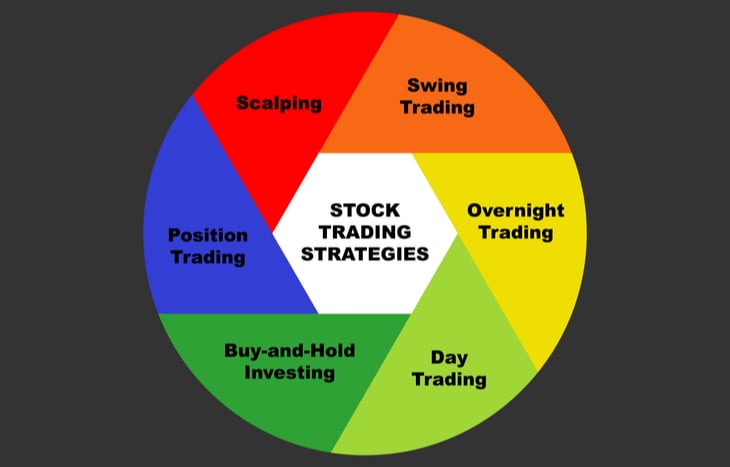Trading stocks is not the same as investing in stocks. Investing aims for steady growth over years. Trading is about timing, managing risk, and making clear decisions in shorter windows. If you want a practical path into stock trading for beginners, start here.
What Is a Stock, in Plain Terms
A stock is a slice of a company. Each share represents a claim on assets and potential profits through dividends. Once listed, shares trade on exchanges where prices move as buyers and sellers update their expectations.
Trading vs. Investing: Which Path Fits You
Investors hold for the long term and let compounding do the heavy lifting. Traders look for shorter moves over minutes, days, or weeks. Many people do both. They keep a long-term core and reserve a smaller sleeve for active trades. Your choice should match your goals, time, and temperament.
Trading Strategies for Short-term Investors
Day trading: Open and close positions within the same day to avoid overnight risk. Focus on liquid stocks, tight risk control, and strict discipline.
Position trading: Hold for weeks to months based on bigger trends and fundamentals. Fewer trades, wider stops, and patience around earnings or macro data.
Scalping: Take many tiny moves for cents per trade in highly liquid names. Requires fast execution, low fees, and strict rules on losses.
Swing trading: Capture multi-day to multi-week swings from support to resistance. Use clear entries, defined stops, and take profits at logical levels.
Momentum trading: Ride strong moves after breakouts or news. Enter with volume confirmation and exit quickly if momentum fades.

Day Trading Rules You Should Know
You can place many trades in a cash account. With margin in the United States, the Pattern Day Trader rule applies. Four or more day trades within five business days can tag your account as a pattern day trader. That requires a minimum balance of 25,000 dollars. Fall below that, and the broker can block new day trades until you restore the balance. If you are just starting, avoid frequent in-and-out trades and focus on swing setups that do not trip the rule.
What to Look For When Buying a Stock
Different styles spot value in different places. Here are three common lenses.
Penny stocks
Shares under 5 dollars often trade off exchanges with thin liquidity. If you explore them, check the basics first. Revenue quality. Debt levels. Cash runway. Spread size and volume. Many beginners learn that “cheap” can get cheaper. Size positions carefully.
Growth stocks
These companies reinvest to expand. They may not pay dividends because cash goes back into the business. Look for accelerating revenue, expanding margins, and a path to positive free cash flow. Expect volatility around earnings dates.
Value stocks
These trade below what the fundamentals suggest they are worth. The market may be too pessimistic. Focus on stable cash flows, sensible leverage, and catalysts that can close the gap between price and value. Patience matters here.
What Moves Stock Prices
Prices move when facts change or when expectations change.
Earnings
Quarterly reports and guidance shifts can reprice a stock in minutes. Watch revenue growth, margins, cash flow, and forward commentary.
Economics
Rates, inflation, employment, and growth data shape risk appetite. Strong economies often support profits. Tight policy can pressure multiples.
Politics and policy
Taxes, trade actions, and elections can move sectors and indexes. Follow the calendar and know when headlines can add volatility.
Stock Trading Advantages
Trading can boost returns when you capture well-defined setups. You stay engaged with markets, learn fast, and can adapt across sectors. You can also scale risk to your comfort if you use clear rules.
Stock Trading Disadvantages
Trading is work. It takes time to research, plan, and manage positions. There is real risk if you size too large, chase moves, or skip stops. If a busy schedule prevents you from monitoring trades, lean toward longer holding periods or pure investing.
How to Start Trading Stocks
Choose a broker
Compare commission structure, order types, platform stability, and risk controls. Make sure the broker supports the markets and order routes you plan to use.
Practice first
Open a demo and test your process. Learn order tickets, stops, and position sizing. Treat virtual trades like real ones. The point is to build muscle memory without paying tuition to the market.
Do focused research
Start with a small watchlist. Read earnings summaries. Check basic valuation and balance sheet health. Map key price levels on the chart so you know where you are wrong before you click buy.
Place the order
Use limit orders to control entry. Add a stop-loss to cap risk and a take-profit or trailing stop to manage the exit. Review the ticket, then send.
Risk Management for Beginners
Risk management keeps you in the game long enough to learn. Many new traders risk 1 to 3 percent of their account per trade. That means your stop distance and position size should work together so a single loss does not damage your account. Avoid clustered risks. Do not put three trades on the same theme and call it diversification.
Stock Trading Tips for Beginners That Actually Work
Master one area before you expand. A single sector or a handful of tickers is plenty while you learn. Keep a trading journal. Record the setup, thesis, entry, stop, target, and outcome. Review weekly and remove what does not work. Be skeptical of social media calls and anonymous “gurus.” If a pitch sounds like a shortcut, it is probably a trap.
Beginner Stock Trading Strategies
Volume analysis
Rising price with rising volume can confirm demand. Use volume spikes to spot breakouts or to see when a move is running out of energy near resistance.
Volatility setups
High volatility creates opportunity and risk. Use indicators like Average True Range to size positions so a normal swing does not knock you out. Consider trading after news once spreads normalize.
Beta awareness
Beta compares a stock’s movement to the market’s. High beta names move more. That can be good for traders who want action, but it demands tighter risk control.
Short-selling basics
Shorting can profit from declines, but losses can exceed your stake if price rises. Beginners should practice on a simulator first. If you do short, define the maximum loss and respect the stop.
Simple Stock Trading Routine for Beginners
On Sunday, build a watchlist of 10 to 15 tickers with catalysts or clean technicals. Mark support, resistance, and earnings dates. Each morning, read overnight headlines, then focus on two or three ideas that still fit your plan. After the close, update your journal with screenshots and notes. Rinse and repeat. Consistency turns scattered trades into a process.
Common Stock Trading Mistakes to Avoid
Oversizing, revenge trading after a loss, moving stops farther away, and chasing parabolic moves are the fastest paths to drawdowns. Another frequent error is trading too many symbols at once. Depth beats breadth when you are new.
FAQs
In a cash account, there is no set trade count limit. With margin in the United States, four or more day trades in five business days can tag you as a pattern day trader and require a 25,000 dollar minimum balance.
Start small. The goal is to learn execution and risk control. You can scale position sizes only after your process proves itself.
Beginners should prefer limit orders to control entry and slippage. Market orders are fine in very liquid names during normal conditions, but use them with care.
No. Price, volume, levels, and a calendar of events will take you far. Add tools only if they improve decisions.
A simple swing approach works. Trade liquid names near clear support or resistance with defined stops and measured position sizes.
This article was originally published on InvestingCube.com. Republishing without permission is prohibited.


